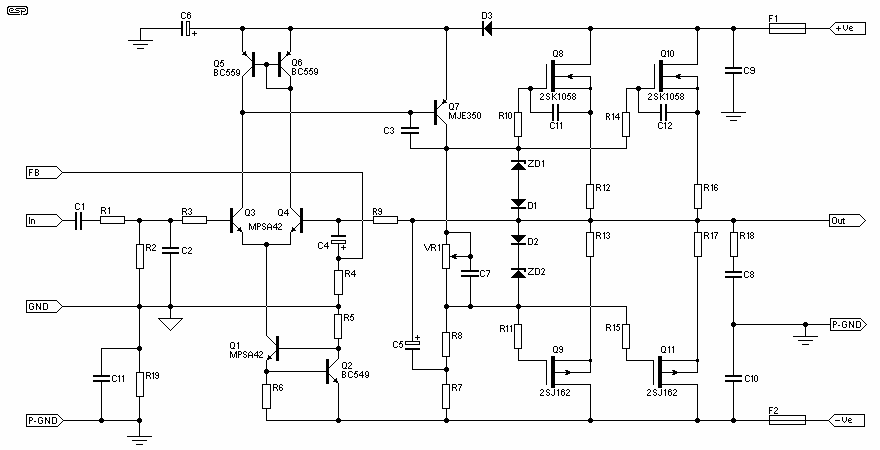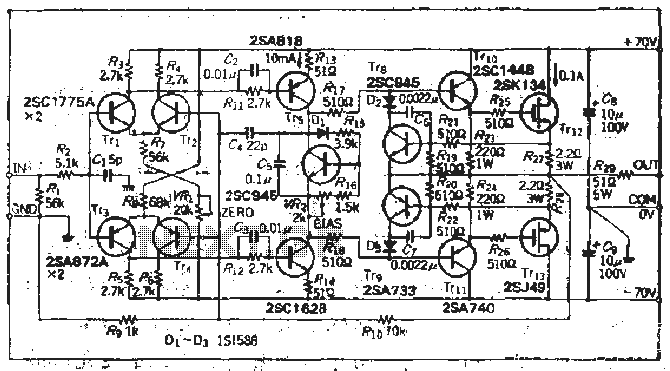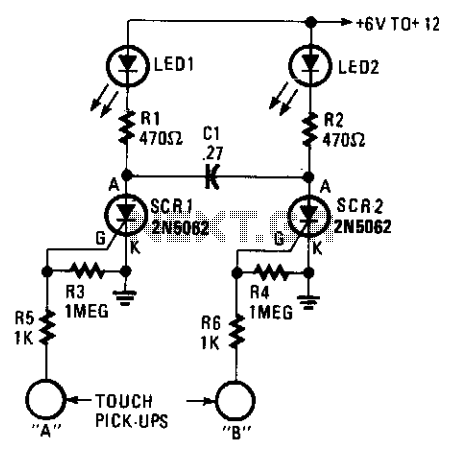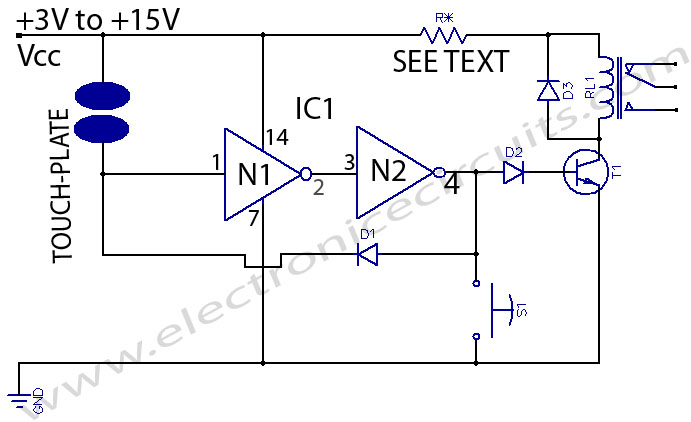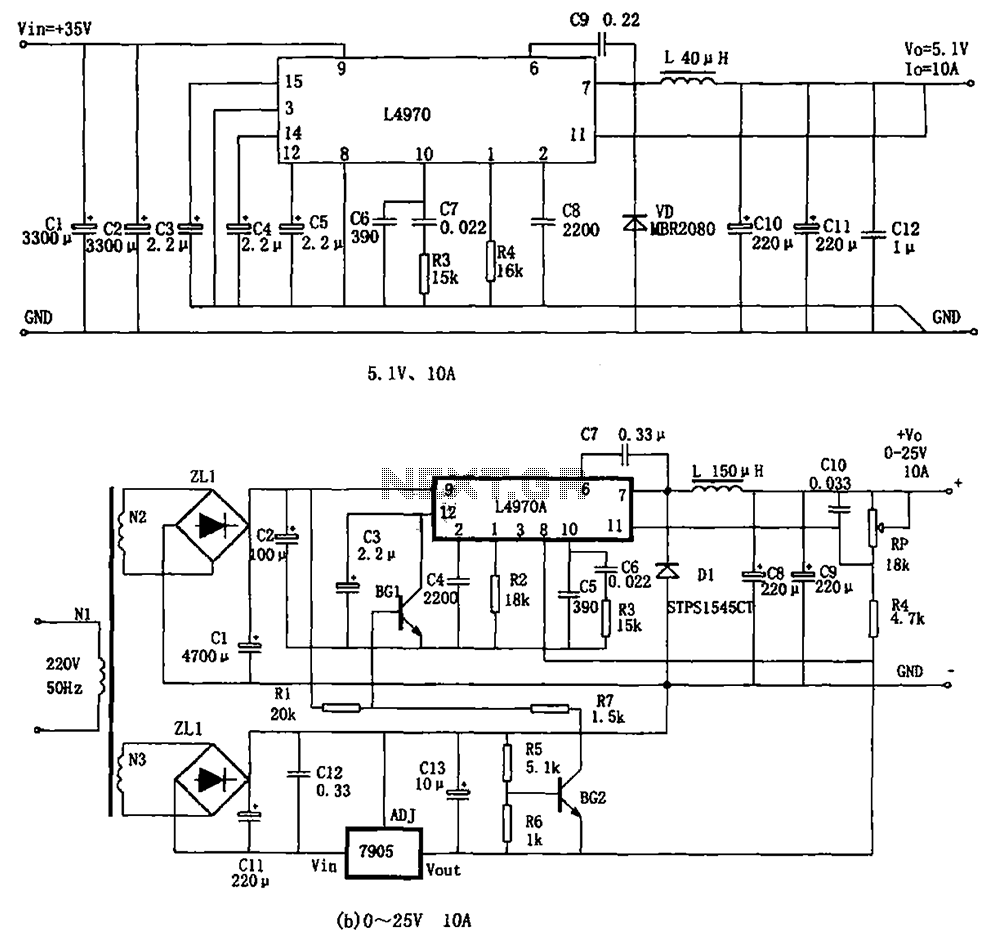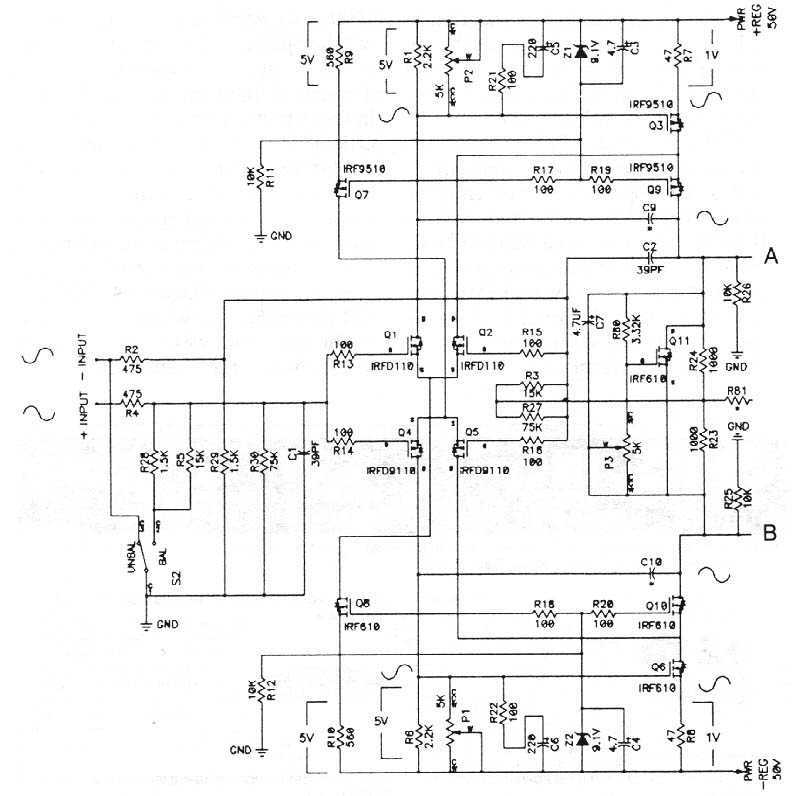
switches MOSFET as a switch
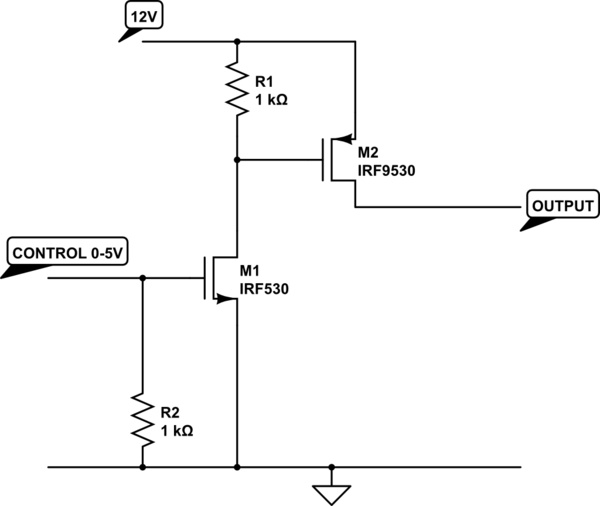
The transistor depicted is a P-channel MOSFET functioning as a high-side switch. Typically, an N-channel MOSFET is preferred for low-side switching, but the P-channel variant can be utilized effectively with the addition of a load at the drain. When the control signal is high (HI), the MOSFET remains off. Conversely, when the control signal is low (LO), the MOSFET operates as a switch, effectively connecting the drain to the source. While this is a simplified explanation, it holds true as long as the transistor is fully saturated. The provided schematic can facilitate the switching of 12V to a load, but it will not pull the output to 0V unless a pull-down resistor is implemented, as indicated in the referenced image. For an N-channel MOSFET, the control logic is inverted: a LO signal turns the switch off, while a HI signal turns it on. N-channel MOSFETs are generally better suited for low-side switching, connecting the output to ground rather than VDD. The gate threshold voltage is the critical voltage level that determines the on/off state of the FET. Logic-level gates operate at lower voltages typical in digital circuits, such as 1.8V, 3.3V, or 5V. It is important to note that merely crossing this threshold does not completely turn the switch on or off; it only allows the FET to begin conducting. To fully turn the FET on or off, the values specified in the datasheet must be adhered to. It is also common practice to incorporate a pull-up resistor (approximately 10k ohms) at the gate of the P-channel MOSFET to maintain an off state during undefined conditions. Similarly, a pull-down resistor is recommended at the gate of the N-channel MOSFET to ensure it remains off during unknown states.
The described circuit utilizing a P-channel MOSFET as a high-side switch operates under the principle of controlling the voltage applied to the gate terminal. The gate is responsible for regulating the conductive state of the MOSFET, which in turn affects the load connected to the drain. A pull-up resistor connected to the gate ensures that the MOSFET remains off when the control signal is not actively driving it, thus preventing unintended activation.
In practical applications, the P-channel MOSFET is connected to the positive supply voltage (VDD), with the load connected between the drain and ground. When the control signal is low, the gate-source voltage (Vgs) becomes negative, allowing the MOSFET to enter saturation and conduct current to the load. The load will receive the full supply voltage, enabling it to operate as intended.
The importance of the pull-down resistor in the N-channel MOSFET configuration cannot be understated. It serves to ensure that the gate is pulled to ground when the control signal is not present, thereby keeping the MOSFET in the off state. This configuration is particularly beneficial in applications where the control signal may be subject to noise or fluctuations, as it provides a reliable means of preventing false triggering.
Understanding the gate threshold voltage is critical when designing circuits with MOSFETs. The threshold voltage is the minimum gate-source voltage required to initiate conduction. Logic-level MOSFETs are designed to operate effectively at lower control voltages, making them suitable for interfacing with microcontrollers and digital logic circuits.
In conclusion, the use of P-channel and N-channel MOSFETs in high-side and low-side switching applications, respectively, provides flexibility in circuit design. Proper implementation of gate control strategies, including the use of pull-up and pull-down resistors, ensures reliable operation and enhances the robustness of the circuit against undefined states.The transistor shown is a P-channel MOSFET acting as a "high-side switch". More commonly, an N-channel MOSFET low-side switch is used, but what you have will work as long once you add something to the drain such as in this image of P-Channel MOSFET switch from : When the control goes "HI" the MOSFET switch is "OFF. " When the control goes "LO" the MOSFET acts as a switch, essentially shorting the drain and source. While this is not entirely true, it is a close approximation as long as the transistor is fully saturated. So the schematic you have shown can be used to switch 12V to something, but it will not connect the output to 0V unless a pull down resistor is used as shown in the above image.
The opposite control scenario works for an N-channel MOSFET: LO control turns the switch off, HI control turns the switch ON. However, an N-channel is more suited to be a "LO-side switch" connecting the output to ground instead of VDD as in this image of an N-Channel MOSFET switch: The actual voltage level that determines if the FET is on or off is known as the gate threshold voltage.
So called "logic level gates" work at lower voltages common in digital circuits such as 1. 8V, 3. 3V, or 5V. Although, crossing this threshold does not entirely turn the switch on or off, it merely allows the FET to start or stop conducting. The FET should be full saturated with the values noted in the datasheet to full turn ON or OFF. I should also add that it is pretty common practice to include a pull up resistor (10k or so) at the gate of the P-Channel MOSFET to keep it OFF in unknown states.
Similarily, a pull down resistor is used at the gate of the N-Channel MOSFET to keep it OFF in unknown states. 🔗 External reference
The described circuit utilizing a P-channel MOSFET as a high-side switch operates under the principle of controlling the voltage applied to the gate terminal. The gate is responsible for regulating the conductive state of the MOSFET, which in turn affects the load connected to the drain. A pull-up resistor connected to the gate ensures that the MOSFET remains off when the control signal is not actively driving it, thus preventing unintended activation.
In practical applications, the P-channel MOSFET is connected to the positive supply voltage (VDD), with the load connected between the drain and ground. When the control signal is low, the gate-source voltage (Vgs) becomes negative, allowing the MOSFET to enter saturation and conduct current to the load. The load will receive the full supply voltage, enabling it to operate as intended.
The importance of the pull-down resistor in the N-channel MOSFET configuration cannot be understated. It serves to ensure that the gate is pulled to ground when the control signal is not present, thereby keeping the MOSFET in the off state. This configuration is particularly beneficial in applications where the control signal may be subject to noise or fluctuations, as it provides a reliable means of preventing false triggering.
Understanding the gate threshold voltage is critical when designing circuits with MOSFETs. The threshold voltage is the minimum gate-source voltage required to initiate conduction. Logic-level MOSFETs are designed to operate effectively at lower control voltages, making them suitable for interfacing with microcontrollers and digital logic circuits.
In conclusion, the use of P-channel and N-channel MOSFETs in high-side and low-side switching applications, respectively, provides flexibility in circuit design. Proper implementation of gate control strategies, including the use of pull-up and pull-down resistors, ensures reliable operation and enhances the robustness of the circuit against undefined states.The transistor shown is a P-channel MOSFET acting as a "high-side switch". More commonly, an N-channel MOSFET low-side switch is used, but what you have will work as long once you add something to the drain such as in this image of P-Channel MOSFET switch from : When the control goes "HI" the MOSFET switch is "OFF. " When the control goes "LO" the MOSFET acts as a switch, essentially shorting the drain and source. While this is not entirely true, it is a close approximation as long as the transistor is fully saturated. So the schematic you have shown can be used to switch 12V to something, but it will not connect the output to 0V unless a pull down resistor is used as shown in the above image.
The opposite control scenario works for an N-channel MOSFET: LO control turns the switch off, HI control turns the switch ON. However, an N-channel is more suited to be a "LO-side switch" connecting the output to ground instead of VDD as in this image of an N-Channel MOSFET switch: The actual voltage level that determines if the FET is on or off is known as the gate threshold voltage.
So called "logic level gates" work at lower voltages common in digital circuits such as 1. 8V, 3. 3V, or 5V. Although, crossing this threshold does not entirely turn the switch on or off, it merely allows the FET to start or stop conducting. The FET should be full saturated with the values noted in the datasheet to full turn ON or OFF. I should also add that it is pretty common practice to include a pull up resistor (10k or so) at the gate of the P-Channel MOSFET to keep it OFF in unknown states.
Similarily, a pull down resistor is used at the gate of the N-Channel MOSFET to keep it OFF in unknown states. 🔗 External reference
